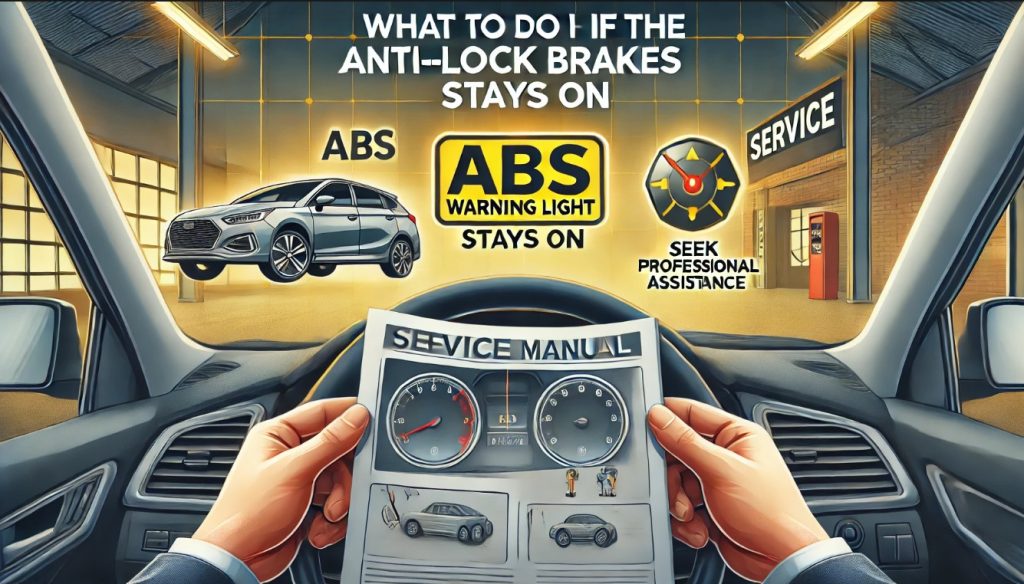Table of Contents
Modern vehicles come equipped with advanced safety features, and one of the most vital systems is the Anti-lock Braking System (ABS).
ABS is designed to prevent wheel lockup during sudden braking, helping you maintain control of your vehicle in emergency situations.
However, like any complex system, the ABS can encounter issues, one of the most common being the ABS warning light staying on.
If this happens, you may be wondering what you should do if your anti-lock brake warning light stays on.
In this blog, we’ll explore the potential causes of the ABS warning light, how to diagnose the problem, and the steps you should take to resolve it.
Understanding these aspects will help you address any issues efficiently and ensure your vehicle remains safe to drive.
What Are Anti-Lock Brake System (ABS)?
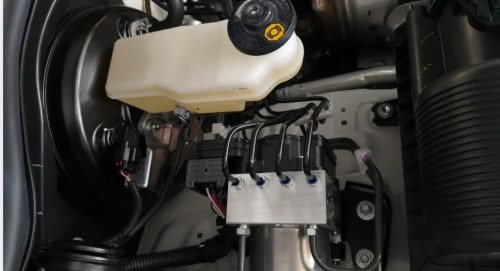
Anti-lock brake system is a vital component of your car’s safety system. They prevent the wheels from locking during heavy braking, reducing the risk of skidding.
ABS is beneficial on slippery roads or in wet weather conditions, where the risk of losing control increases.
By rapidly modulating the brake pressure, ABS allows you to maintain steering control, ensuring your safety and that of other road users.
Before the invention of ABS, drivers often had to rely on a technique called cadence braking, where they manually pumped the brakes to prevent skidding. ABS automates this process, making it far more effective and efficient.
It works by using sensors to monitor the speed of each wheel. If the system detects that one or more wheels are about to lock, it reduces brake pressure momentarily to allow the wheels to continue rotating.
Overall, ABS improves your ability to stop quickly and safely, even in challenging driving conditions. It is an essential feature in modern vehicles, contributing significantly to road safety by reducing the likelihood of accidents.
How Are Anti-Lock Brakes Different from Regular Brakes?
The main difference between anti-lock brakes (ABS) and regular brakes lies in their functionality and safety features.
While both are designed to slow down or stop the vehicle, ABS incorporates sensors and a controller that help prevent wheel lockup during emergency braking situations. The key differences are;
Functionality
- Regular brakes rely on the driver’s pressure on the brake pedal to engage the braking system.
- ABS uses sensors to detect potential wheel lockups and automatically adjusts brake pressure to prevent them.
Control
- Regular brakes can lead to skidding, making it harder to steer during sudden stops.
- ABS helps maintain steering control, allowing you to avoid obstacles while braking.
Performance in Adverse Conditions
- Regular brakes may be less effective on slippery surfaces like ice or wet roads.
- ABS improves performance in such conditions by reducing stopping distances and providing better control.
In summary, while regular brakes form the basic braking system, ABS enhances safety by offering advanced technology that improves vehicle control, especially in emergency or slippery conditions.
What Is an Anti-Lock Brake System (ABS) Warning Light?
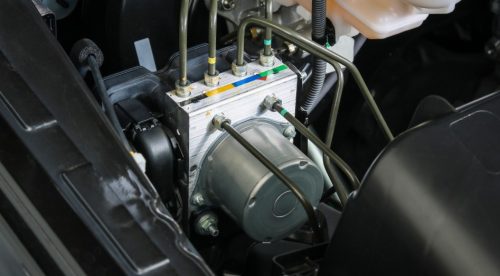
The ABS warning light is a dashboard indicator that alerts you to potential issues with your vehicle’s Anti-lock Braking System.
When you start your car, the ABS light briefly illuminates as part of a standard system check. If it turns off within a few seconds, everything is functioning correctly. However, if the light stays on, it signifies that there might be a problem with the ABS system.
The ABS warning light could indicate several issues, such as a malfunctioning sensor, low brake fluid, or a faulty ABS control module.
It serves as an early warning, prompting you to investigate the problem before it compromises your vehicle’s braking performance.
It’s important to note that while the ABS warning light relates explicitly to the anti-lock system, it doesn’t mean your standard brakes have failed.
However, the added safety feature of ABS may not function, which could increase the risk of losing control during emergency braking. Your safety while driving can be improved by taking quick care of the problem.
Why Does the Anti-Lock Brakes Warning Light Stay On?
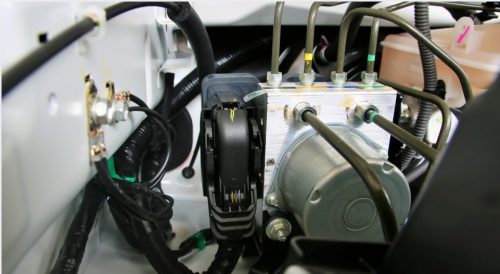
The ABS warning light can remain illuminated for various reasons, each requiring different levels of attention. Common causes include:
- Faulty ABS Sensors: These sensors monitor the speed of each wheel. If one malfunctions, the system may interpret it as a problem, triggering the warning light.
- Low Brake Fluid Levels: Brake fluid is necessary for your braking system to operate properly. A drop in fluid levels can cause the ABS light to turn on.
- Damaged ABS Module: The ABS control module manages the system’s operations. If it becomes damaged, the ABS may fail to function correctly, resulting in a warning light.
- Electrical Issues: Problems with wiring or a blown fuse can also cause the ABS light to stay on.
Understanding these causes can help you determine the best course of action when the ABS warning light appears.
What Should You Do if Your Anti Lock Brakes Warning Light Stays on?
If your Anti-lock Brakes (ABS) warning light stays on, it’s essential to address the issue immediately.
Although it may still be safe to drive, the ABS system’s malfunction could compromise your braking performance, so it’s best to seek professional help.
Here are some steps to take if the ABS light remains on:
1. Check Your Brake Fluid
- The ABS warning light may be activated by low brake fluid.
- Inspect the brake fluid level in the reservoir and top it up, if necessary, to the correct level marked on the side.
2. Perform a System Reset
- Sometimes, the ABS light may be caused by a temporary issue or system error.
- Turning off and restarting your car could reset the system, potentially turning off the warning light.
3. Inspect the ABS Fuse
- In the event that an ABS fuse blows, the warning light may illuminate.
- Consult your car’s manual for the fuse location and replace it if necessary.
4. Disconnect and Reconnect the Battery
- Disconnecting the battery can reset the car’s computer system, potentially clearing the ABS light, but this is typically a temporary solution.
5. Call a Mechanic
- If the ABS light remains on after trying the above steps, call your garage.
- They may advise you on the next course of action or send someone to check your vehicle to ensure your safety.
Always check your car’s manual for specific guidance on the ABS warning light, and remember that if your brakes are malfunctioning, you should avoid driving until the issue is resolved.
Why You Should Never Ignore the ABS Warning Light?
Ignoring the ABS warning light can have serious consequences. The ABS is a critical safety feature, and neglecting its malfunction could lead to increased risks, including:
- Longer Stopping Distances: Your car might take longer to stop completely without ABS, particularly on slippery or wet conditions.
- Loss of Steering Control: ABS helps maintain control during hard braking. Without it, you may lose the ability to steer safely.
- Increased Risk of Skidding: Without ABS, your car is more likely to skid during emergency braking, putting you and others at risk.
Addressing ABS issues promptly is essential for maintaining vehicle safety and avoiding costly repairs.
What Maintenance Practices Can Prevent ABS Warning Light Malfunctions?
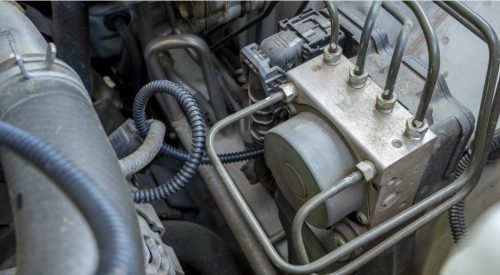
Preventive maintenance is essential for ensuring your Anti-lock Braking System (ABS) stays in optimal condition.
By regularly maintaining your braking system, you can reduce the likelihood of ABS-related malfunctions and ensure your safety while driving.
Here are some effective practices to prevent ABS warning light issues:
- Regular Brake Inspections: Schedule routine brake inspections with a professional technician to identify potential problems early. This can help prevent more significant issues from developing.
- Check Brake Fluid Levels: Low or contaminated brake fluid can negatively impact ABS performance. Pay attention to the fluid levels and change them as advised by the manufacturer of your car.
- Replace Worn Components: Worn brake pads, rotors, or ABS sensors can interfere with system functionality. Ensure these components are replaced when necessary to maintain optimal braking power.
- Avoid Hard Braking: Frequent and harsh braking can put undue stress on your ABS, potentially leading to malfunctions.
By following these simple maintenance practices, you can help keep your ABS system functioning efficiently and reduce the likelihood of warning light issues.
How Much Does It Cost to Repair an ABS Warning Light Issue?
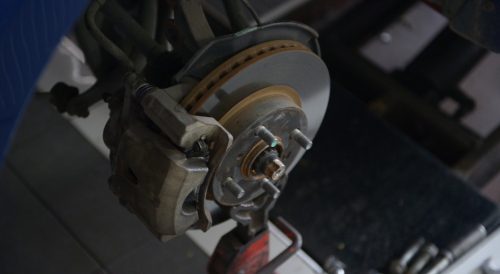
The cost of repairing an ABS warning light issue varies depending on the cause. Common repairs include:
- Replacing ABS Sensors: Typically costs between £100 and £200 per sensor, including parts and labour.
- Repairing the ABS Module: Depending on the extent of the damage, this can cost anywhere from £300 to £800.
- Fixing Electrical Issues: Repairing wiring or fuses is generally more affordable, costing between £50 and £150.
The exact cost will depend on the make and model of your vehicle, as well as the complexity of the issue. Consulting a trusted mechanic can help you understand the required repairs and associated costs.
Conclusion
The ABS warning light is an important indicator of possible problems with the anti-lock braking system in your car.
Ignoring it can compromise your safety and vehicle performance, particularly in emergency braking situations.
Addressing the underlying causes promptly, whether it’s low brake fluid, a blown fuse, or a system error, can help maintain optimal braking function.
Regular vehicle maintenance and timely intervention can significantly reduce the risk of ABS malfunctions.
Always prioritize your safety and consult a professional mechanic if the light stays on or if you suspect an issue. Ensuring your ABS system works properly is essential for safe and efficient driving.
FAQs
Is it safe to drive with the ABS warning light on?
No, driving with the ABS light on can compromise safety, especially in emergency braking situations.
Can you reset the ABS warning light yourself?
Yes, you can reset it by restarting the car or using a diagnostic tool, but only after addressing the underlying issue.
Can a low battery cause the ABS warning light to illuminate?
Yes, a low or failing battery can cause voltage fluctuations that trigger the ABS warning light.
Does the ABS light affect the MOT test in the UK?
Yes, an illuminated ABS warning light will likely result in an MOT failure as it indicates a safety issue.
How do weather conditions affect the ABS system?
Extreme cold or wet conditions can affect ABS sensors, potentially causing the warning light to turn on.
What happens if you ignore the ABS warning light for too long?
Ignoring the ABS warning light may result in additional harm, higher repair expenses, and increased safety hazards.
Can a DIY diagnostic tool accurately identify ABS issues?
Yes, a DIY diagnostic tool can identify ABS issues, but it is advisable to consult a professional for accurate diagnosis and repairs.




